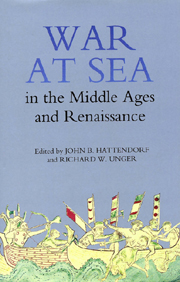Book contents
- Frontmatter
- Contents
- List of illustrations
- List of Contributors
- Preface
- Acknowledgements
- Introduction: Theories of Naval Power: A. T. Mahan and the Naval History of Medieval and Renaissance Europe
- I Northern Europe
- II Southern Europe
- Byzantium and the Sea: Byzantine Fleets and the History of the Empire in the Age of the Macedonian Emperors, c.900–1025 CE
- Iberian Naval Power, 1000–1650
- Venice, Genoa and Control of the Seas in the Thirteenth and Fourteenth Centuries
- Genoese Naval Forces in the Mediterranean during the Fifteenth and Sixteenth Centuries
- An Exemplary Maritime Republic: Venice at the End of the Middle Ages
- III Sixteenth and Early-Seventeenth-Century Europe
- Conclusion: Toward a History of Medieval Sea Power
- Index
- Titles in the series
Venice, Genoa and Control of the Seas in the Thirteenth and Fourteenth Centuries
from II - Southern Europe
Published online by Cambridge University Press: 05 April 2013
- Frontmatter
- Contents
- List of illustrations
- List of Contributors
- Preface
- Acknowledgements
- Introduction: Theories of Naval Power: A. T. Mahan and the Naval History of Medieval and Renaissance Europe
- I Northern Europe
- II Southern Europe
- Byzantium and the Sea: Byzantine Fleets and the History of the Empire in the Age of the Macedonian Emperors, c.900–1025 CE
- Iberian Naval Power, 1000–1650
- Venice, Genoa and Control of the Seas in the Thirteenth and Fourteenth Centuries
- Genoese Naval Forces in the Mediterranean during the Fifteenth and Sixteenth Centuries
- An Exemplary Maritime Republic: Venice at the End of the Middle Ages
- III Sixteenth and Early-Seventeenth-Century Europe
- Conclusion: Toward a History of Medieval Sea Power
- Index
- Titles in the series
Summary
WHEN trying to find the underlying and developing ideas of naval operations and strategy in the events of the naval conflicts between the Italian maritime states of the thirteenth and fourteenth centuries, the fundamental questions are: (1) What do the actions of the hostile parties reveal about the war aims of the participants? (2) How did these change over time if, indeed, they did? (3) What strategies were developed to achieve those aims? In practical affairs, it is common for theory to lag well behind practice. Alfred Thayer Mahan's influential analysis of naval strategy was based on a study of sailing navies that were obsolete in the time that he was writing. This is not to suggest that the commanders of the sailing navies of the sixteenth to the eighteenth centuries did not grasp the concept of global strategy nor that naval commanders in the fourteenth century did not have clear goals. Rather, it suggests that the theoretical articulation of complex concepts often follows a thorough testing of ideas in the practical sphere. That, in turn, suggests that to understand the development of certain ideas in their contemporary context, one must look to the actions of the participants as indications of the thought processes that guided them.
- Type
- Chapter
- Information
- War at Sea in the Middle Ages and the Renaissance , pp. 119 - 136Publisher: Boydell & BrewerPrint publication year: 2002



